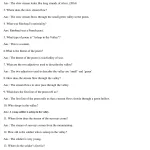Asleep in the Valley is a poignant poem by Arthur Rimbaud, capturing the innocence and tragedy of war through vivid imagery. This detailed question and answer guide helps students explore its themes, poetic techniques, and deeper meanings while preparing for exams or broadening their understanding.
Questions and Answers on the Poem’s Themes
Question: What is the central theme of “Asleep in the Valley”?
Answer: The central theme is the innocence of youth destroyed by the harsh realities of war, portrayed through a peaceful yet tragic depiction of a soldier’s death.
Question: How does the poet contrast life and death in the poem?
Answer: The poet contrasts life and death by depicting a serene valley filled with nature’s beauty alongside the tragic image of the dead soldier lying peacefully.
Question: What role does nature play in the poem?
Answer: Nature acts as a silent observer, symbolizing peace and beauty while serving as the final resting place for the fallen soldier.
Question: How is the theme of war explored in the poem?
Answer: War is explored subtly, focusing on its aftermath—the tragic death of a soldier and its impact on the innocence of nature.
Question: Why does the poet use a tranquil setting to depict death?
Answer: The tranquil setting emphasizes the irony of peace juxtaposed with the tragedy of war, highlighting the senselessness of violence.
Question: What does the title “Asleep in the Valley” signify?
Answer: The title suggests a peaceful rest in nature, masking the grim reality of the soldier’s death due to war.
Question: How does the poem reflect the futility of war?
Answer: The poem reflects the futility of war by showing the needless loss of young life in a serene, untouched natural setting.
Question: What message does the poet convey about life and death?
Answer: The poet conveys that life and death coexist, and death can sometimes be hidden under the guise of peace and beauty.
Question: How does the poem evoke empathy for the soldier?
Answer: The poem evokes empathy by portraying the soldier as a young, innocent individual who meets an untimely and tragic end.
Question: Why is the soldier described as “asleep”?
Answer: The soldier is described as “asleep” to emphasize the peacefulness of his appearance, masking the reality of his death.
Questions and Answers on Poetic Devices
Question: What poetic devices are used in “Asleep in the Valley”?
Answer: The poem uses imagery, irony, symbolism, and alliteration to create a vivid and emotional depiction of the scene.
Question: How is imagery used effectively in the poem?
Answer: Imagery is used to describe the serene valley, the soldier, and the surroundings, making the contrast between life and death more poignant.
Question: What is the significance of the word “hollow” in the poem?
Answer: The word “hollow” symbolizes emptiness, reflecting both the valley’s peacefulness and the soldier’s lifelessness.
Question: How does the poet use irony in the poem?
Answer: Irony is used by portraying the soldier’s death in a peaceful, beautiful setting, contrasting the violence of war with nature’s serenity.
Question: What is the role of symbolism in the poem?
Answer: The valley symbolizes nature’s indifference, while the soldier represents the tragedy of war, creating a powerful symbolic contrast.
Question: How does the poet create a contrast between the living and the dead?
Answer: The poet creates this contrast by describing the lively, vibrant valley alongside the lifeless body of the soldier.
Question: What is the tone of the poem?
Answer: The tone is melancholic and reflective, blending the beauty of nature with the tragedy of war.
Question: How is alliteration used in the poem?
Answer: Alliteration enhances the musical quality of the poem, such as in the repetition of sounds in “sun-soaked” and “small green.”
Question: What role does personification play in the poem?
Answer: Personification is used to bring nature to life, making the valley seem like a silent, compassionate observer.
Question: Why does the poet use vivid descriptions in the poem?
Answer: Vivid descriptions immerse the reader in the scene, heightening the emotional impact of the soldier’s death.
Questions and Answers on the Poet’s Intentions
Question: What inspired Arthur Rimbaud to write this poem?
Answer: Arthur Rimbaud was inspired by his experiences and observations of war, reflecting his pacifist views and empathy for human suffering.
Question: What does the poet want readers to feel about war?
Answer: The poet wants readers to feel the senselessness and tragedy of war, evoking empathy for its innocent victims.
Question: How does the poem criticize war indirectly?
Answer: The poem criticizes war by showing its devastating consequences through the image of a young soldier’s untimely death.
Question: Why does the poet focus on the soldier’s innocence?
Answer: The poet highlights the soldier’s innocence to underscore the tragic loss of young lives in war.
Question: How does the poem reflect human vulnerability?
Answer: The poem reflects human vulnerability by showing how even the beauty of nature cannot shield humanity from the horrors of war.
Question: Why does the poet not describe the war directly?
Answer: The poet avoids direct descriptions to focus on the human cost of war, making the impact more emotional and universal.
Question: What is the significance of the soldier’s “two red holes”?
Answer: The “two red holes” symbolize the soldier’s wounds, subtly revealing the violence of his death.
Question: How does the poem reflect universal themes?
Answer: The poem reflects universal themes of life, death, peace, and the tragedy of war, making it relatable across cultures and times.
Question: Why does the poet use a peaceful setting to convey a tragic message?
Answer: The peaceful setting creates a stark contrast, emphasizing the irony and senselessness of war’s destruction.
Question: What emotional response does the poem aim to evoke?
Answer: The poem aims to evoke sorrow, empathy, and a reflection on the devastating impact of war on innocent lives.
Questions and Answers for Exam Preparation
Question: Explain the significance of the valley in the poem.
Answer: The valley symbolizes peace, serenity, and the eternal rest of the soldier, contrasting with the violence of war.
Question: What does the phrase “gentle sun” suggest in the poem?
Answer: The phrase “gentle sun” suggests warmth and care, as if nature is mourning and comforting the fallen soldier.
Question: How is the soldier’s youth highlighted in the poem?
Answer: The soldier’s youth is highlighted through descriptions of his innocent appearance and peaceful rest, evoking a sense of tragic loss.
Question: How does the poet describe the soldier’s physical appearance?
Answer: The poet describes the soldier as lying peacefully, with a smile on his face, appearing as though he is asleep.
Question: What is the significance of the soldier’s smile?
Answer: The soldier’s smile signifies peace in death, masking the pain and violence of his demise.
Question: How does the poem portray the contrast between nature and war?
Answer: Nature is portrayed as serene and nurturing, contrasting with the violence and destruction of war represented by the soldier’s death.
Question: What is the role of light imagery in the poem?
Answer: Light imagery, like the “gentle sun,” conveys warmth and peace, adding to the poem’s poignant contrast between life and death.
Question: Why is the soldier described as being “in the valley”?
Answer: The soldier is described as being “in the valley” to symbolize his eternal rest in nature’s embrace, far from the chaos of war.
Question: How does the poem address the universal cost of war?
Answer: The poem addresses the universal cost of war by depicting the loss of young, innocent lives, a tragedy that transcends time and place.
Question: How does the poem’s structure contribute to its message?
Answer: The poem’s structure, with its gentle flow and vivid imagery, mirrors the peaceful yet tragic narrative, enhancing the emotional impact.
Asleep in the Valley is a timeless reminder of the human cost of war and the fragility of life. Through vivid imagery and poignant themes, the poem encourages readers to reflect on the value of peace and the senselessness of violence, making it a deeply emotional and thought-provoking piece.
Latest Posts
- Step-by-step guide to download and apply for jee mains admit card 202
- Comprehensive 2025 government holidays and recruitment details for job seekers
- JEE Mains Admit Card 2025: Your Step-by-Step Guide to Downloading the Hall Ticket
- Everything You Need to Know About 2025 Government Holidays Recruitment
- Comprehensive Guide to rrb d group recruitment 2025 – Eligibility, Vacancies, and Application
- Detailed guide to nps trust recruitment 2025 vacancies, eligibility and apply process
- Comprehensive guide to hpcl recruitment 2025 notification, vacancies, and application process
- ignou bed admission 2025 complete recruitment guide with eligibility and process
- Comprehensive Guide to Indian Army Agniveer Recruitment 2025 Notification and Jobs
- Everything You Must Know About CBSE Board Exams 2025 Changes & New Rules




